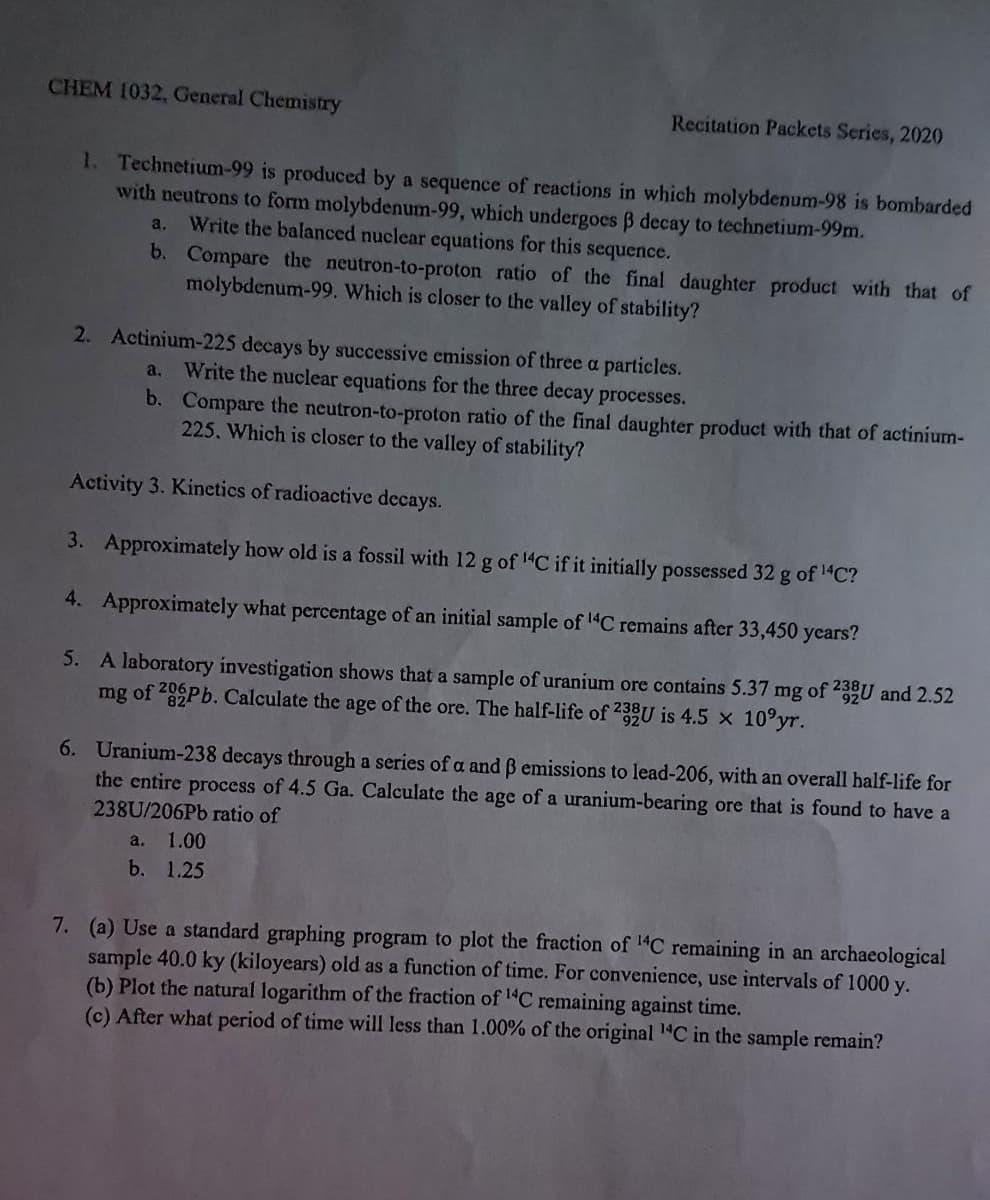2. Actinium-225 decays by successive emission of three a particles. a. Write the nuclear equations for the three decay processes. b. Compare the neutron-to-proton ratio of the final daughter product with that of actinium- 225. Which is closer to the valley of stability?
2. Actinium-225 decays by successive emission of three a particles. a. Write the nuclear equations for the three decay processes. b. Compare the neutron-to-proton ratio of the final daughter product with that of actinium- 225. Which is closer to the valley of stability?
Chemistry for Engineering Students
4th Edition
ISBN:9781337398909
Author:Lawrence S. Brown, Tom Holme
Publisher:Lawrence S. Brown, Tom Holme
Chapter14: Nuclear Chemistry
Section: Chapter Questions
Problem 14.36PAE
Related questions
Question
Q2

Transcribed Image Text:CHEM 1032, General Chemistry
Recitation Packets Series, 2020
1. Technetium-99 is produced by a sequence of reactions in which molybdenum-98 is bombarded
with neutrons to form molybdenum-99, which undergoes B decay to technetium-99m.
Write the balanced nuclear equations for this sequence.
a.
b. Compare the neutron-to-proton ratio of the final daughter product with that of
molybdenum-99. Which is closer to the valley of stability?
2. Actinium-225 decays by successive emission of three a particles.
Write the nuclear equations for the three decay processes.
b. Compare the neutron-to-proton ratio of the final daughter product with that of actinium-
225. Which is closer to the valley of stability?
a,
Activity 3. Kinetics of radioactive decays.
3. Approximately how old is a fossil with 12 g of 14C if it initially possessed 32 g of 1"C?
4. Approximately what percentage of an initial sample of "C remains after 33,450 years?
5. A laboratory investigation shows that a sample of uranium ore contains 5.37 mg of 235U and 2.52
mg of 20 Pb. Calculate the age of the ore. The half-life of 235U is 4.5 x 10°yr.
6. Uranium-238 decays through a series of a and B emissions to lead-206, with an overall half-life for
the entire process of 4.5 Ga. Calculate the age of a uranium-bearing ore that is found to have a
238U/206P6 ratio of
a.
1.00
b. 1.25
7. (a) Use a standard graphing program to plot the fraction of C remaining in an archaeological
sample 40.0 ky (kiloyears) old as a function of time. For convenience, use intervals of 1000 y.
(b) Plot the natural logarithm of the fraction of l C remaining against time.
(c) After what period of time will less than 1.00% of the original 1C in the sample remain?
Expert Solution
This question has been solved!
Explore an expertly crafted, step-by-step solution for a thorough understanding of key concepts.
This is a popular solution!
Trending now
This is a popular solution!
Step by step
Solved in 2 steps

Knowledge Booster
Learn more about
Need a deep-dive on the concept behind this application? Look no further. Learn more about this topic, chemistry and related others by exploring similar questions and additional content below.Recommended textbooks for you

Chemistry for Engineering Students
Chemistry
ISBN:
9781337398909
Author:
Lawrence S. Brown, Tom Holme
Publisher:
Cengage Learning


Principles of Modern Chemistry
Chemistry
ISBN:
9781305079113
Author:
David W. Oxtoby, H. Pat Gillis, Laurie J. Butler
Publisher:
Cengage Learning

Chemistry for Engineering Students
Chemistry
ISBN:
9781337398909
Author:
Lawrence S. Brown, Tom Holme
Publisher:
Cengage Learning


Principles of Modern Chemistry
Chemistry
ISBN:
9781305079113
Author:
David W. Oxtoby, H. Pat Gillis, Laurie J. Butler
Publisher:
Cengage Learning


Chemistry
Chemistry
ISBN:
9781305957404
Author:
Steven S. Zumdahl, Susan A. Zumdahl, Donald J. DeCoste
Publisher:
Cengage Learning

Chemistry & Chemical Reactivity
Chemistry
ISBN:
9781133949640
Author:
John C. Kotz, Paul M. Treichel, John Townsend, David Treichel
Publisher:
Cengage Learning